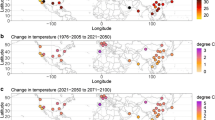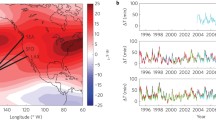Abstract
Steadily rising mean and extreme temperatures as a result of climate change will likely impact the air transportation system over the coming decades. As air temperatures rise at constant pressure, air density declines, resulting in less lift generation by an aircraft wing at a given airspeed and potentially imposing a weight restriction on departing aircraft. This study presents a general model to project future weight restrictions across a fleet of aircraft with different takeoff weights operating at a variety of airports. We construct performance models for five common commercial aircraft and 19 major airports around the world and use projections of daily temperatures from the CMIP5 model suite under the RCP 4.5 and RCP 8.5 emissions scenarios to calculate required hourly weight restriction. We find that on average, 10–30% of annual flights departing at the time of daily maximum temperature may require some weight restriction below their maximum takeoff weights, with mean restrictions ranging from 0.5 to 4% of total aircraft payload and fuel capacity by mid- to late century. Both mid-sized and large aircraft are affected, and airports with short runways and high temperatures, or those at high elevations, will see the largest impacts. Our results suggest that weight restriction may impose a non-trivial cost on airlines and impact aviation operations around the world and that adaptation may be required in aircraft design, airline schedules, and/or runway lengths.



Similar content being viewed by others
References
Anderson JD (2015) Introduction to flight. McGraw-Hill Education, New York
Boeing (2013). 737 airplane characteristics for airport planning
Burbidge R (2016) Adapting European airports to a changing climate. Transp Res Procedia 14:14–23
Coffel E, Horton R (2015) Climate change and the impact of extreme temperatures on aviation. Weather Clim Soc 7:94–102
Coffel ED, Horton RM (2016) Reply to ‘“Comment on ‘Climate change and the impact of extreme temperatures on aviation’”’. AMS Weather Clim Soc 8:207–208
Collins, M. et al., (2013) in Intergovernmental Panel on Climate Change, Working Group I Contribution to the IPCC Fifth Assessment Report (AR5) (Cambridge University Press, New York) (eds. Stocker, T. F. et al.) (Cambridge University Press)
Coumou D, Lehmann J, Beckmann J (2015) The weakening summer circulation in the Northern Hemisphere mid-latitudes. Science 348(80):324–327
Dole R et al (2011) Was there a basis for anticipating the 2010 Russian heat wave? Geophys Res Lett 38
EUROCONTROL (2004). Experimental centre. User manual for the Base of Aircraft Data (BADA)
Fleurquin P, Ramasco JJ, Eguiluz VM (2013) Systemic delay propagation in the US airport network. Sci Rep 3:1159
Hane FT (2015) Comment on ‘Climate change and the impact of extreme temperatures on aviation’. Weather Clim Soc 8:205–206
Hansen J, Sato M, Ruedy R (2012) Perception of climate change. Proc Natl Acad Sci U S A 109:E2415–E2423
Hinkel J et al (2014) Coastal flood damage and adaptation costs under 21st century sea-level rise. Proc Natl Acad Sci U S A 111:3292–3297
Horton RM, Coffel ED, Winter JM, Bader DA (2015) Projected changes in extreme temperature events based on the NARCCAP model suite. Geophys Res Lett:1–10. doi:10.1002/2015GL064914
Horton RM, Mankin JS, Lesk C, Coffel E, Raymond C (2016) A review of recent advances in research on extreme heat events. Curr Clim Chang Rep 2:242–259
ICAO (2016) Environmental report
Karl TR et al (2015) Possible artifacts of data biases in the recent global surface warming hiatus. Science 348(80):1469–1472
Kharin VV, Zwiers FW, Zhang X, Hegerl GC (2007) Changes in temperature and precipitation extremes in the IPCC Ensemble of Global Coupled Model Simulations. J Clim 20:1419–1444
Knutson TR et al (2010) Tropical cyclones and climate change. Nat Geosci 3:157–163
Kodra E, Ganguly AR (2014) Asymmetry of projected increases in extreme temperature distributions. Sci Rep 4:5884
Koetse MJ, Rietveld P (2009) The impact of climate change and weather on transport: an overview of empirical findings. Transp Res Part D Transp Environ 14:205–221
Lan S, Clarke J-P, Barnhart C (2006) Planning for robust airline operations: optimizing aircraft routings and flight departure times to minimize passenger disruptions. Transp Sci 40:15–28
Mora C et al (2013) The projected timing of climate departure from recent variability. Nature 502:183–187
Moss RH et al (2010) The next generation of scenarios for climate change research and assessment. Nature 463:747–756
O’Gorman Pa, Schneider T (2009) The physical basis for increases in precipitation extremes in simulations of 21st-century climate change. Proc Natl Acad Sci U S A 106:14773–14777
Pal JS, Eltahir EAB (2015) Future temperature in southwest Asia projected to exceed a threshold for human adaptability. Nat Clim Chang 18203:1–4
Parris, A. et al. (2012). Global sea level rise scenarios for the United States National Climate Assessment. At http://cpo.noaa.gov/sites/cpo/Reports/2012/NOAA_SLR_r3.pdf
Schär C et al (2004) The role of increasing temperature variability in European summer heatwaves. Nature 427:332–336
Sherwood SC, Huber M (2010) An adaptability limit to climate change due to heat stress. Proc Natl Acad Sci U S A 107:9552–9555
Stott PA, Stone DA, Allen MR (2004) Human contribution to the European heatwave of 2003. Nature. doi:10.1029/2001JB001029
Taylor KE, Stouffer RJ, Meehl G a (2012) An overview of CMIP5 and the experiment design. Bull Am Meteorol Soc 93:485–498
Thompson TR (2016) Aviation and the impacts of climate change ∙ climate change impacts upon the commercial air transport industry: an overview. Carbon Clim Law Rev 10:105–112
Walsh, J. et al. (2014) Chapter 2: Our changing climate. Third US Natl. Clim. Assess
Webster PJ, Holland GJ, Curry Ja, Chang H-R (2005) Changes in tropical cyclone number, duration, and intensity in a warming environment. Science 309:1844–1846
Williams PD (2016) Transatlantic flight times and climate change. Environ Res Lett 11
Williams PD (2017) Increased light, moderate, and severe clear-air turbulence in response to climate change. Adv Atmos Sci 34:576–586
Williams PD, Joshi MM (2013) Intensification of winter transatlantic aviation turbulence in response to climate change. Nat Clim Chang 3:644–648
Yin JH (2005) A consistent poleward shift of the storm tracks in simulations of 21st century climate. Geophys Res Lett 32:1–4
Acknowledgments
We acknowledge the World Climate Research Programme’s Working Group on Coupled Modelling, which is responsible for the CMIP, and we thank the climate modeling groups for producing and making available their model output. For the CMIP, the US Department of Energy’s Program for Climate Model Diagnosis and Intercomparison provided coordinating support and led the development of software infrastructure in partnership with the Global Organization for Earth System Science Portals. Funding for this research was provided through NSF grant number DGE-11-44155 and the US DOI.
Author information
Authors and Affiliations
Contributions
E.D.C. and T.R.T. jointly conceived of the study, conducted the analyses, and wrote the paper. R.M.H. provided the input at all stages.
Corresponding author
Electronic supplementary material
ESM 1
(DOCX 16000 kb)
Rights and permissions
About this article
Cite this article
Coffel, E.D., Thompson, T.R. & Horton, R.M. The impacts of rising temperatures on aircraft takeoff performance. Climatic Change 144, 381–388 (2017). https://doi.org/10.1007/s10584-017-2018-9
Received:
Accepted:
Published:
Issue Date:
DOI: https://doi.org/10.1007/s10584-017-2018-9




